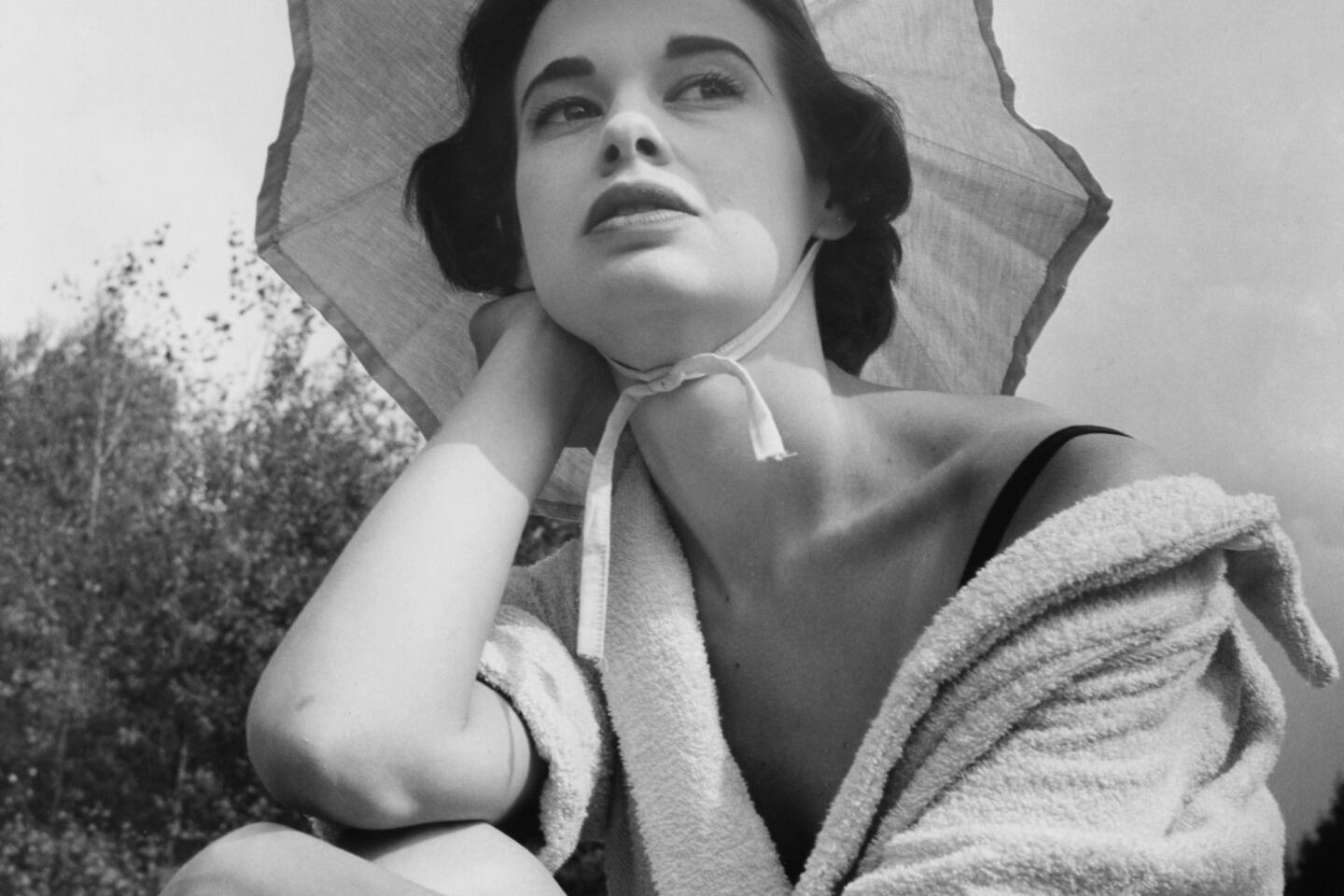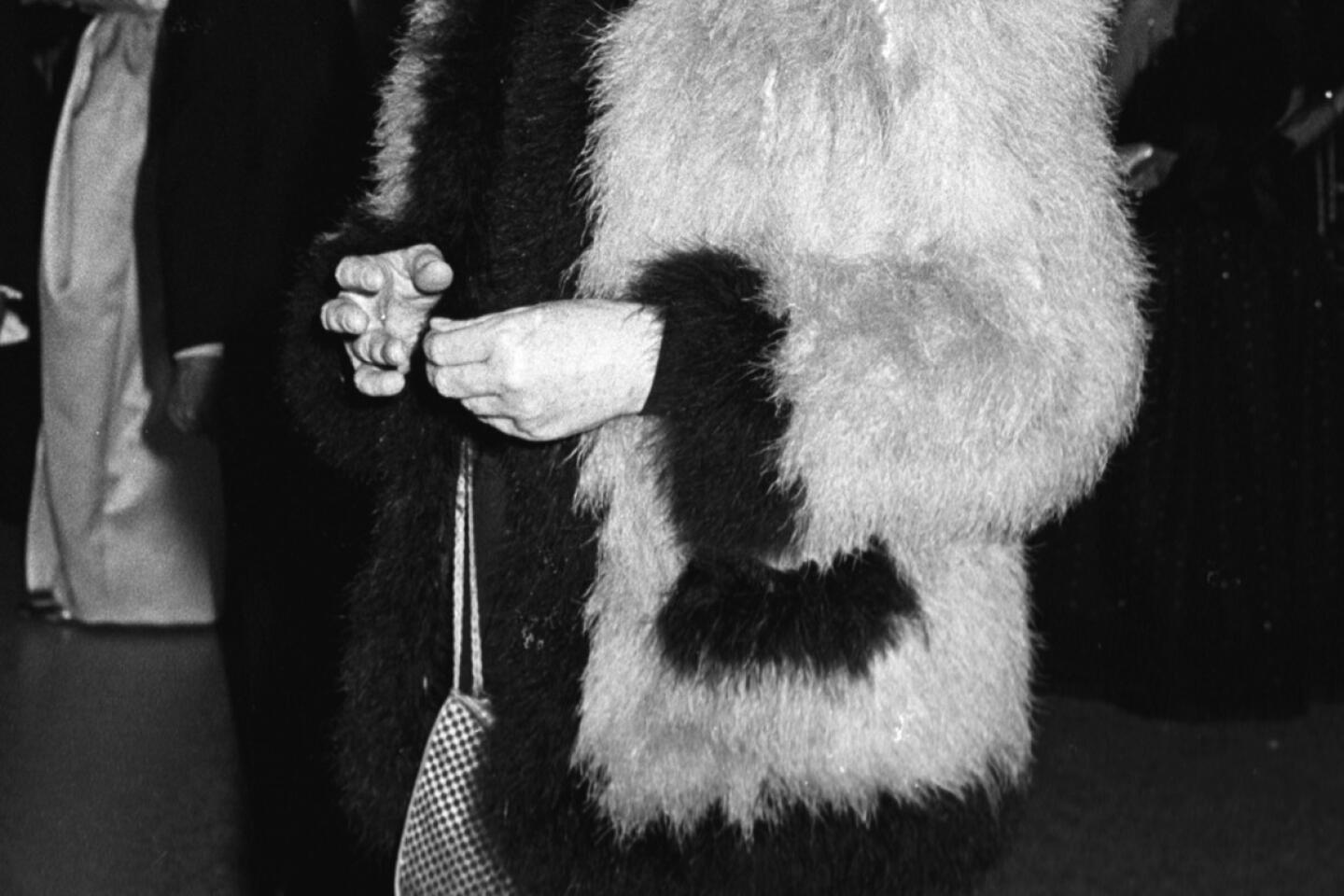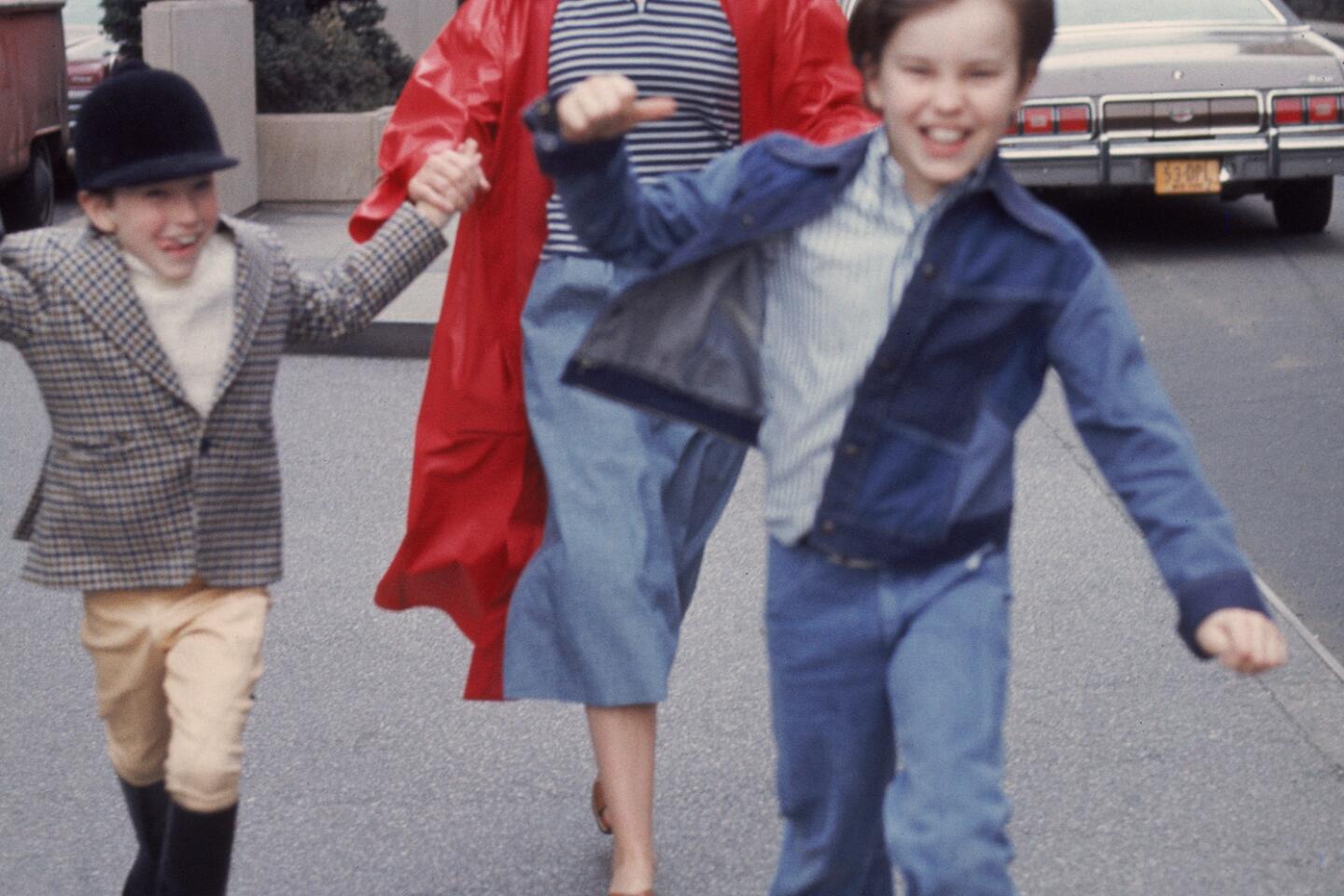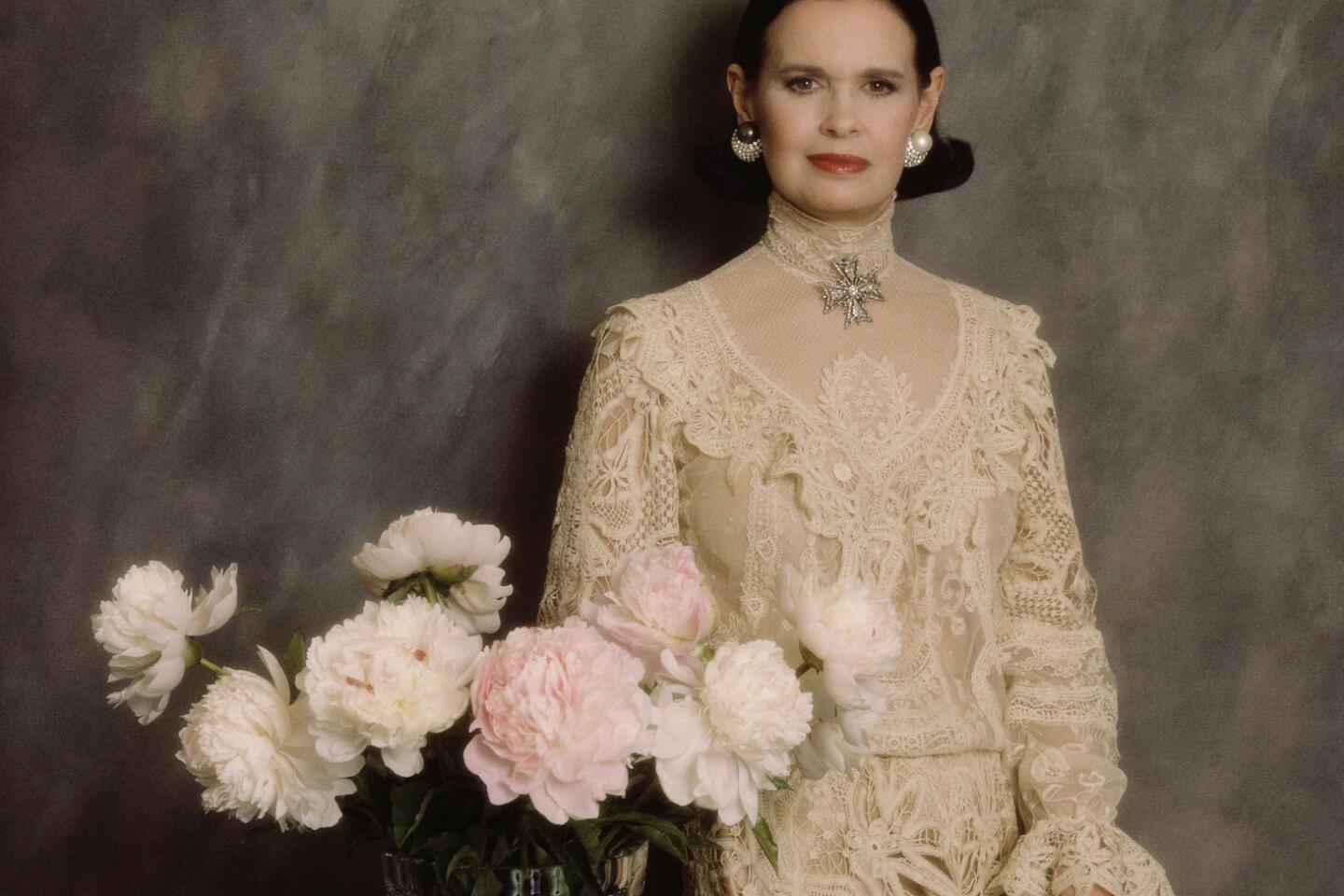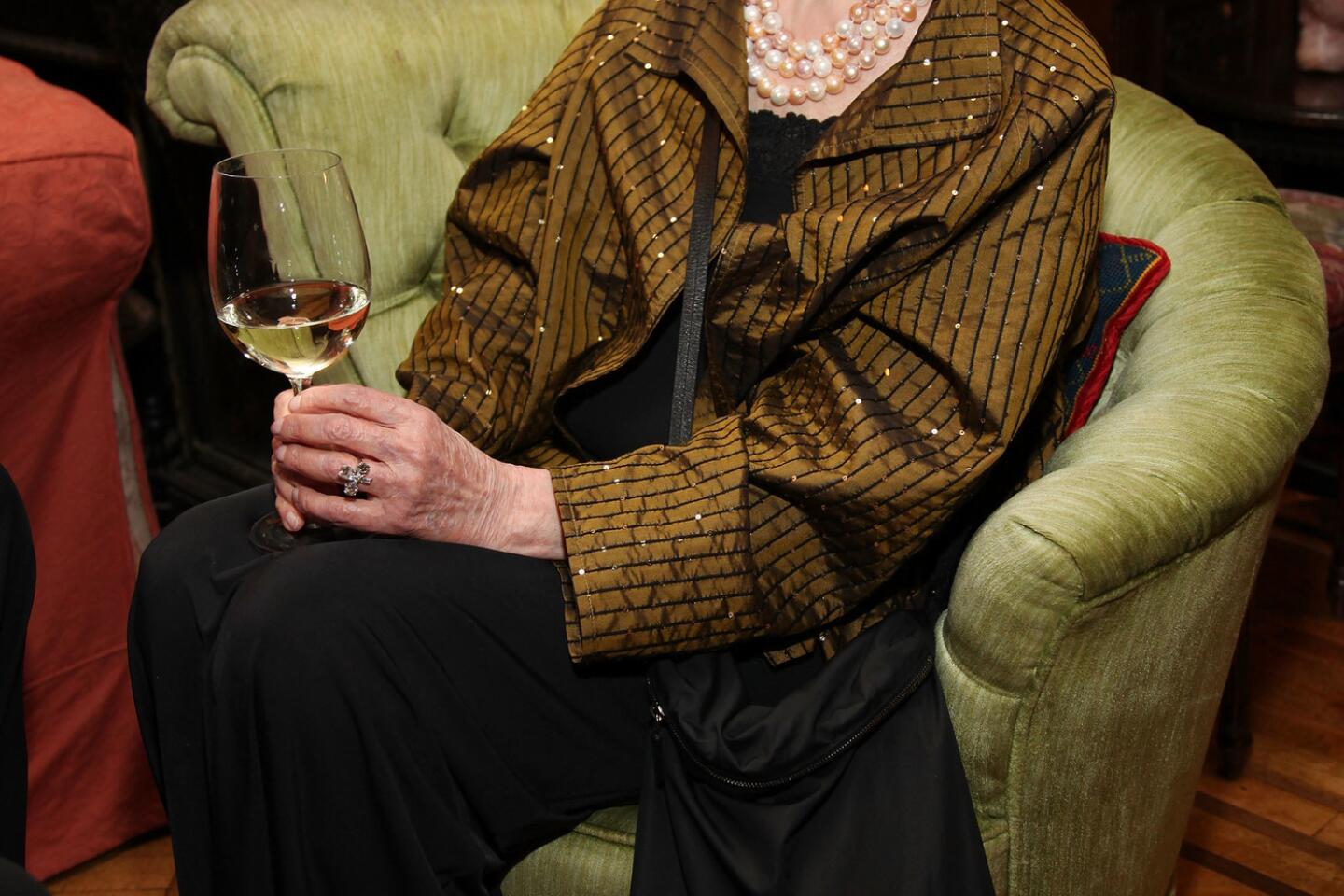Gloria Vanderbilt, heiress, socialite and fashion entrepreneur, dies at 95

Vanderbilt, the intrepid heiress, artist and romantic who began her extraordinary life as the “poor little rich girl” of the Great Depression, survived family tragedy and multiple marriages, died Monday at age 95.
- Share via
Gloria Vanderbilt experienced both loss and triumph on a grand scale.
Her multimillionaire father died when she was 2, leading her socialite mother to abandon her for the high life on two continents. She was wrenched from a beloved nurse who raised her from birth after a sensational 1934 custody battle won by her aunt, the formidable art patron Gertrude Vanderbilt Whitney.
Over the next decades, her self-described “restless search for love” led to affairs with Marlon Brando and Howard Hughes and to four husbands, including conductor Leopold Stokowski and director Sidney Lumet. She found happiness in her last marriage, to writer Wyatt Emory Cooper, only to see it end with his early death at 50 from a heart attack. That loss was compounded when she witnessed the suicide of one of their sons.
But the “poor little rich girl,” as newspapers long ago had tagged the heiress, transcended her famously disjointed childhood and later upheavals to become an actress, artist, author and fashion and merchandising icon. She ultimately created a fortune that, she often noted, exceeded the immense one left by her great-great-grandfather, 19th-century shipping and railroad baron Cornelius Vanderbilt.
“Gloria Vanderbilt was an extraordinary woman who loved life and lived it on her own terms,” her son Anderson Cooper, the CNN anchor, said in a statement to The Times following her death Monday at her home in New York City. “She was 95 years old, but ask anyone close to her, and they’d tell you, she was the youngest person they knew, the coolest, and most modern.”
The cause was advanced stomach cancer, which Cooper said had been diagnosed earlier this month.
Her life fed the imagination of writer Truman Capote, who used Vanderbilt as a model for Holly Golightly, the hedonistic heroine of his 1958 novel, “Breakfast at Tiffany’s.”
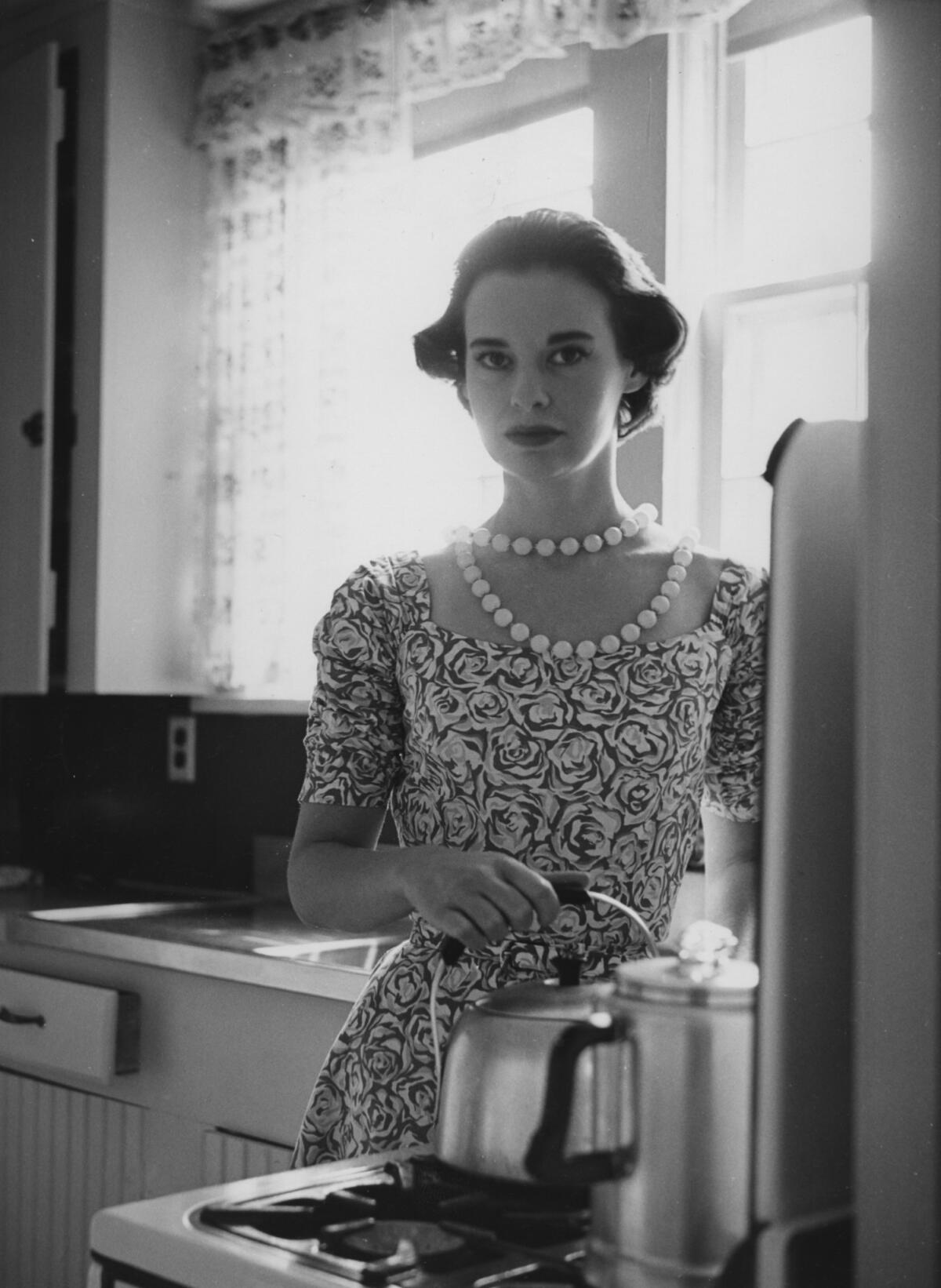
Vanderbilt ended her friendship with Capote after he portrayed her as a vacuous socialite who fails to recognize a former husband in “La Cote Basque,” a 1975 short story later published as a chapter of his unfinished novel, “Answered Prayers.”
To later generations, Vanderbilt was best known for putting her name on a slew of mass-marketed merchandise — linens, stemware, perfumes and, most notably, a line of tight-fitting designer jeans — that launched celebrity branding in fashion and other everyday wares.
“The thing that really made Gloria Vanderbilt penetrate the American consciousness was the blue jeans war of the late ’70s and early 1980s,” said Robert Thompson, professor of pop culture at Syracuse University. “The jeans moved from being functional clothes to designer jeans...it was her attempt to take something that was so unglamorous and invest it in high fashion style.
“The blue jeans war gave her identity as a socialite,” Thompson said.

She later lost millions in a swindle masterminded by two trusted advisors — her psychiatrist and her lawyer. But her name remained a potent marketing ploy, revived in the early 2000s by companies that hoped the glamorous Vanderbilt brand would sell everything from bath towels to watches.
In 2009, when she was 85, Vanderbilt raised eyebrows with the release of an erotic novel, “Obsession,” about a woman who discovers her dead husband’s kinky affair with a dominatrix. The New York Times described it as “the steamiest book ever written by an octogenarian.”
The Vanderbilts, once the richest family in America, exemplified the excesses of the Gilded Age. They built palaces to rival the grandest French chateaus, including the Breakers, the most sumptuous of Newport, R.I.’s, “summer cottages” for the rich, and no fewer than 10 mansions on New York’s Fifth Avenue. Their immense wealth was owed to the labors of Cornelius Vanderbilt, known as the Commodore, who turned a Staten Island boat service into a steamship empire before expanding into railroads. His fortune, estimated at $95 million at his death in 1877, enabled the next generations’ extravagance.
Reginald Claypoole Vanderbilt, the Commodore’s great-grandson, was a sportsman and profligate gambler when he married Gloria Laura Morgan, a Swiss-born socialite who was 17 to his 42. She agreed to marry him even though he explained that she would be a “Mrs. Vanderbilt with no money” because he had already squandered his $13-million inheritance.
He died two years later, in 1925, of an internal hemorrhage brought on by heavy drinking. The only money left was a $5-million trust fund to be split between little Gloria, born on Feb. 24, 1924, in New York, and a daughter from a previous marriage.
The young Vanderbilt widow decamped to Europe after securing a $4,000 monthly allowance from her daughter’s share of the trust. While she partied among the international elite in London, Paris, Biarritz and Monte Carlo, Gloria was raised by her grandmother and nurse, whose devotion never fulfilled her yearning for her mother’s love.
“How I longed to merge into her,” Vanderbilt wrote of her mother in her bestselling 1985 memoir, “Once Upon a Time.” “But then she would go away, down the long corridors of hotels, down staircases, along avenues in her pale furs, snow-sprinkled, disappearing into the velvet caverns of waiting cars and borne away, away, away.”
When her mother announced plans to marry a destitute German prince, familial warfare commenced, pitting the widow Gloria against her own mother, Laura Kilpatrick Morgan.
Grandmother Morgan viewed her daughter’s lifestyle as decadent and was determined to preserve little Gloria’s inheritance. She enlisted the help of Gertrude Vanderbilt Whitney, Reginald Vanderbilt’s sister, to wrest control of the girl from her mother.
At the 1934 custody trial, Morgan testified that she did not know of “any time in which my daughter expressed concern over the baby’s welfare or showed any mark of affection for her.” Little Gloria told the judge that she hated her mother.
But the most scandalous testimony came from a Parisian maid, who said she had seen her mistress in bed being kissed by another woman, a member of the British royal family. Such revelations spurred Cholly Knickerbocker, a prominent society columnist, to sneer that the custody battle was “as disgusting an exhibition of public laundering of soiled family linen as I’ve ever encountered.”
Although the public rooted for Gloria Morgan Vanderbilt, the court awarded permanent custody to the icy Whitney, who dismissed the beloved nurse and sent her niece to her Long Island estate while she spent most of her time in the city. “As soon as my aunt was allowed to take charge of me,” Vanderbilt observed years later, “she lost interest.”
A staple of newspaper front pages all during the trial, Vanderbilt’s troubles made the dark days of the Great Depression a little brighter for the general public: It inspired the 1936 Shirley Temple movie “The Poor Little Rich Girl.” Vanderbilt mansions had begun falling to the wrecker’s ball, and the fate of the Vanderbilt heiress was seen as a “bewitching reminder,” family historian Arthur T. Vanderbilt II wrote in his 1989 book, “Fortune’s Children,” of “an age that was suddenly over.”
Vanderbilt lived in her aunt’s house under strict supervision until she was 17. Then, during a visit with her mother in Beverly Hills, “the door of the cage was open, and out I flew.” She dated Van Heflin and billionaire Hughes, who offered her a screen test.
In 1941, she married Pasquale “Pat” Di Cicco, a Hollywood talent agent who had once been married to Thelma Todd, the actress who died mysteriously in 1935. He was verbally and physically abusive, but it took three years for Vanderbilt to officially end the marriage.
The day after her Reno divorce in 1944, Vanderbilt eloped to Mexico with Stokowski, who was 62 to her 20. The next year she came into her inheritance, which had grown to more than $4 million. Stokowski urged her to cut off financial support to her mother. She followed his advice and did not see her mother for the next 17 years. By the time they reconciled, in the 1960s, Gloria Morgan Vanderbilt was suffering from hysterical blindness. She died in 1967.
Five years into the marriage with Stokowski, Vanderbilt had what one biographer called a nervous breakdown and entered psychoanalysis. Encouraged by the analyst to find creative outlets, she began to paint and took acting lessons. She made her stage debut in 1954 in a Pocono Playhouse production of Ferenc Molnar’s “The Swan” and received good reviews. She also appeared on Broadway in a 1955 revival of William Saroyan’s Pulitzer Prize-winning play, “The Time of Your Life.”
When Vanderbilt began painting, she often drew inspiration from other women. Following news of her death, Joyce Carol Oates, author and National Book Award winner, shared photos and portraits on Twitter that Vanderbilt painted of her years ago. Oates described Vanderbilt’s work to the New York Times Style Magazine as having a “dimension of affection, an emotional tie that doesn’t necessarily get into photographs.”
Near the end of her marriage to Stokowski, she had an affair with Brando, whom she portrayed in her 2004 memoir, “It Seemed Important at the Time,” as such a narcissist that the main adornment in his bedroom was “a 10-by-12-inch drop-dead-gorgeous photograph (of himself).”
She also had an affair with Frank Sinatra, the “white knight” in the title of her second memoir, “Black Knight, White Knight,” published in 1987. She said that his affections gave her the courage to divorce Stokowski in 1955. She won custody of their sons, Stanislaus and Christopher, and won. They survive her, along with son Cooper.
Vanderbilt had extended her acting career to television by the time she married her next husband, Lumet. Years later, she described him as “a wonderful husband and stepfather to my two Stokowski sons,” but did not explain the reasons behind the dissolution of their seven-year marriage beyond acknowledging that she “hadn’t been fair to him and sometimes behaved badly.”
In 1963, she married Wyatt Cooper and had two sons, Carter and Anderson. She later wrote that she was grateful to Wyatt Cooper for teaching her “what the loving parenting I’d never had could be like.” He died after a series of heart attacks in 1977.
That year she agreed to lend her celebrity aura to Murjani International, which had been seeking a high-profile woman to help it capture the status jeans market. Within a few short years, she became the queen of high-fashion jeans tailored for women with normal, not model-thin, bodies.
The elegant heiress with the slick pageboy and wide grin attracted crowds at department store promotions and starred in an advertising blitzkrieg that showed off her denim-clad derriere. By 1979, her line was making a reported $150 million a year for Murjani, surpassing the enormously popular Calvin Klein jeans in sales. Her success earned her a spot in a 1990 Smithsonian exhibit on gender and style that included Gloria Vanderbilt jeans alongside the creations of such icons as Coco Chanel and Bill Blass.
In 1985, she published “Once Upon a Time,” which covered her life to age 17. The first in a series of autobiographies, it won high marks from critics at publications such as the New York Times Book Review, which called it “an extraordinary book ... a cry of the heart that speaks to the child in all of us.”
The peace Vanderbilt had finally achieved in the last half of her life was shattered on a summer evening in 1978 when her son Carter, a 23-year-old Princeton graduate who was being treated for depression, visited her Manhattan penthouse.
She was in her bedroom when Carter suddenly walked in, saying: “What’s going on? What’s going on?” Then he ran from the room.
She found him straddling a low wall that formed an outside balcony. Despite her entreaties, he deftly climbed over the wall and let go.
His death, she later told an interviewer, “shattered the glass bubble I’ve always felt I lived in.”
She wanted to die.
Not until months later, when she joined a suicide support group, did she begin to feel she could go on living. She said she wrote “A Mother’s Story” in 1996 to share that hope with others who had experienced great tragedy. The slim volume, written as a letter with flashbacks that one critic described as “at once grotesque and beautiful,” earned warm reviews.
“I have no respect for anyone that has self-pity,” Vanderbilt told a reporter in 2000. “It is a loathsome trait. Nobody is spared in life. There is one big test as there is one big goodbye. Mine came early, that’s all — and I’m still here.”
Elaine Woo is a former Times staff writer.
Times staff writer Dorany Pineda contributed to this report.
More to Read
Start your day right
Sign up for Essential California for the L.A. Times biggest news, features and recommendations in your inbox six days a week.
You may occasionally receive promotional content from the Los Angeles Times.
